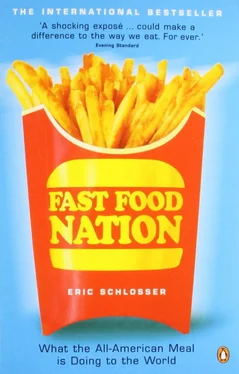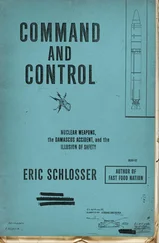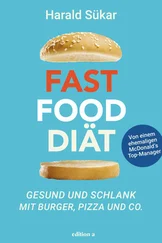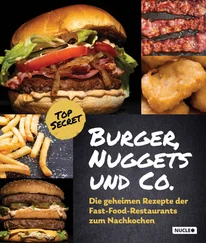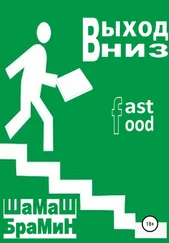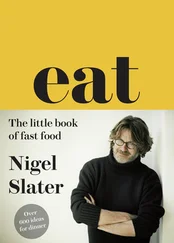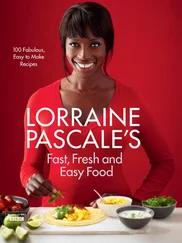The headquarters of CKE is still located on the property where the Heinz family once grew oranges. Today there’s no smell of citrus in the air, no orange groves in sight. In a town that once had endless rows of orange and lemon trees, stretching far as the eye could see, there’s not an acre of them left, not a single acre devoted to commercial citrus growing. Anaheim’s population is now about three hundred thousand, roughly thirty times what it was when Carl first arrived. On the corner where Carl’s Drive-In Barbeque once stood, there’s a strip mall. Near the CKE headquarters on Harbor Boulevard, there’s an Exxon station, a discount mattress store, a Shoe City, a Las Vegas Auto Sales store, and an off-ramp of the Riverside Freeway. The CKE building has a modern, Spanish design, with white columns, red brick arches, and dark plate-glass windows. When I visited recently, it was cool and quiet inside. After passing a life-size wooden statue of St. Francis of Assisi on a stairway landing, I was greeted at the top of the stairs by Carl N. Karcher.
Carl looked like a stylish figure from the big-band era, wearing a brown checked jacket, a white shirt, a brown tie, and jaunty two-tone shoes. He was tall and strong, and seemed in remarkably good shape. The walls of his office were covered with plaques and mementos, with photographs of Carl beside presidents, famous ballplayers, former employees, grandchildren, priests, cardinals, Mikhail Gorbachev, the Pope. Carl proudly removed a framed object from the wall and handed it to me. It was the original receipt for $326, confirming the purchase of his first hot dog cart.
Eight weeks after being locked out of his office in 1993, Carl engineered a takeover of the company. Through a complex series of transactions, a partnership headed by financier William P. Foley II assumed some of Carl’s debts, received much of his stock in return, and took control of CKE. Foley became the new chairman of the board. Carl was named chairman emeritus and got his old office back. Almost all of the executives and directors who had opposed him subsequently left the company. The Green Burrito plan was adopted and proved a success. The new management at CKE seemed to have turned the company around, raising the value of its stock. In July of 1997, CKE purchased Hardee’s for $327 million, thereby becoming the fourth-largest hamburger chain in the United States, joining McDonald’s, Burger King, and Wendy’s at the top. And signs bearing the Carl’s Jr. smiling little star started going up across the United States.
Carl seemed amazed by his own life story as he told it. He’d been married to Margaret for sixty years. He’d lived in the same Anaheim house for almost fifty years. He had twenty granddaughters and twenty grandsons. For a man of eighty, he had an impressive memory, quickly rattling off names, dates, and addresses from half a century ago. He exuded the genial optimism and good humor of his old friend Ronald Reagan. “My whole philosophy is — never give up,” Carl told me. “The word ‘can’t’ should not exist… Have a great attitude… Watch the pennies and the dollars will take care of themselves… Life is beautiful, life is fantastic, and that is how I feel about every day of my life.” Despite CKE’s expansion, Carl remained millions of dollars in debt. He’d secured new loans to pay off the old ones. During the worst of his financial troubles, advisers pleaded with him to declare bankruptcy. Carl refused; he’d borrowed more than $8 million from family members and friends, and he would not walk away from his obligations. Every weekday he was attending Mass at six o’clock in the morning and getting to the office by seven. “My goal in the next two years,” he said, “is to pay off all my debts.”
I looked out the window and asked how he felt driving through Anaheim today, with its fast food restaurants, subdivisions, and strip malls. “Well, to be frank about it,” he said, “I couldn’t be happier.” Thinking that he’d misunderstood the question, I rephrased it, asking if he ever missed the old Anaheim, the ranches and citrus groves.
“No,” he answered. “I believe in Progress.”
Carl grew up on a farm without running water or electricity. He’d escaped a hard rural life. The view outside his office window was not disturbing to him, I realized. It was a mark of success.
“When I first met my wife,” Carl said, “this road here was gravel and now it’s blacktop.”
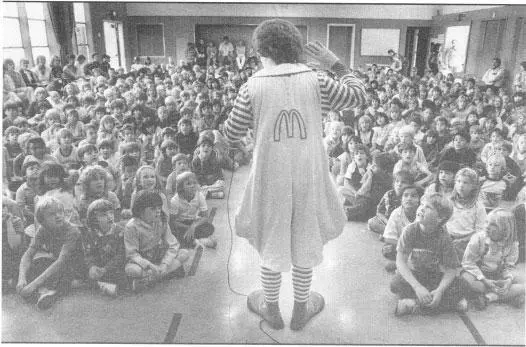
2/your trusted friends
BEFORE ENTERING the Ray A. Kroc Museum, you have to walk through McStore. Both sit on the ground floor of McDonald’s corporate headquarters, located at One McDonald’s Plaza in Oak Brook, Illinois. The headquarters building has oval windows and a gray concrete façade — a look that must have seemed space-age when the building opened three decades ago. Now it seems stolid and drab, an architectural relic of the Nixon era. It resembles the American embassy compounds that always used to attract antiwar protesters, student demonstrators, flag burners. The eighty-acre campus of Hamburger University, McDonald’s managerial training center, is a short drive from headquarters. Shuttle buses constantly go back and forth between the campus and McDonald’s Plaza, ferrying clean-cut young men and women in khakis who’ve come to study for their “Degree in Hamburgerology.” The course lasts two weeks and trains a few thousand managers, executives, and franchisees each year. Students from out of town stay at the Hyatt on the McDonald’s campus. Most of the classes are devoted to personnel issues, teaching lessons in teamwork and employee motivation, promoting “a common McDonald’s language” and “a common McDonald’s culture.” Three flagpoles stand in front of McDonald’s Plaza, the heart of the hamburger empire. One flies the Stars and Stripes, another flies the Illinois state flag, and the third flies a bright red flag with golden arches.
You can buy bean-bag McBurglar dolls at McStore, telephones shaped like french fries, ties, clocks, key chains, golf bags and duffel bags, jewelry, baby clothes, lunch boxes, mouse pads, leather jackets, postcards, toy trucks, and much more, all of it bearing the stamp of McDonald’s. You can buy T-shirts decorated with a new version of the American flag. The fifty white stars have been replaced by a pair of golden arches.
At the back of McStore, past the footsteps of Ronald McDonald stenciled on the floor, past the shelves of dishes and glassware, a bronze bust of Ray Kroc marks the entrance to his museum. Kroc was the founder of the McDonald’s Corporation, and his philosophy of QSC and V — Quality, Service, Cleanliness, and Value — still guide it. The man immortalized in bronze is balding and middle-aged, with smooth cheeks and an intense look in his eyes. A glass display case nearby holds plaques, awards, and letters of praise. “One of the highlights of my sixty-first birthday celebration,” President Richard Nixon wrote in 1974, “was when Tricia suggested we needed a ‘break’ on our drive to Palm Springs, and we turned in at McDonald’s. I had heard for years from our girls that the ‘Big Mac’ was really something special, and while I’ve often credited Mrs. Nixon with making the best hamburgers in the world, we are both convinced that McDonald’s runs a close second… The next time the cook has a night off we will know where to go for fast service, cheerful hospitality — and probably one of the best food buys in America.” Other glass cases contain artifacts of Kroc’s life, mementos of his long years of struggle and his twilight as a billionaire. The museum is small and dimly lit, displaying each object with reverence. The day I visited, the place was empty and still. It didn’t feel like a traditional museum, where objects are coolly numbered, catalogued, and described. It felt more like a shrine.
Читать дальше
